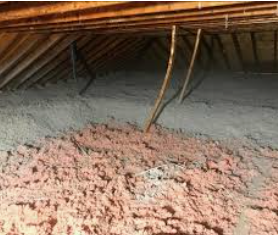If you are looking for attic insulation in Mississauga, ON, you should know about the different types of insulation materials. Learning about the insulation materials will help you select the most appropriate insulation for your home. Many people start searching for attic insulation in GTA without proper insulation knowledge. Due to this, they face many difficulties in finding the best company. There are many kinds of insulation materials ranging from bulky fiber materials, including rock and slag wool, fiberglass, natural fibers, and cellulose, to rigid foam insulation materials. The bulky insulation materials are highly resistive against the heat transfer. Therefore, many people prefer these materials for attic insulation in Mississauga, ON, in the winter. The bulky materials in insulation stop heat loss and help maintain the inner home temperature. This blog will help you know the different types of insulating materials.
Fiberglass
As the name implies, this insulation material contains glass in the form of fine fibers. Therefore, it is among the most ubiquitous materials. The insulation companies commonly use fiberglass insulation in two types of insulation: blanket and lose-filled. The insulation is also available as duct and rigid board insulation.
Manufacturers are now producing medium and high-density fiberglass insulation products. The R Values of these products are slightly higher than the standard batts. People who want R Values somewhat higher than the standard insulation can go with fiberglass attic insulation in GTA.
This type of insulation is made of molten glass. The molten glass is spun or blown into fibers. The manufacturers decide the quantity of recycled glass content in fiberglass insulation. Generally, recycled glass content varies from 40% to 60%.
Mineral Wool Insulation Materials
The mineral wool insulation comprises two types of insulation materials:
- Rockwool: It is a human-made insulation material that consists of natural materials like diabase or basalt.
- Slag wool: It is also a human-made material obtained from blast furnace slag.
Mineral wool insulation contains about 75% post-industrial recycled material. Also, it does not require any additional chemicals to make it fireproof. This insulation is commonly available in the form of loose-fill and blanket insulation.
Natural Fiber Insulation
Manufacturers use natural fibers like cotton, sheep’s wool, straw, hemp, etc., to make natural fiber insulation. This type of insulation does not cause any harm to the environment. Therefore, if you are looking for eco-friendly attic insulation in Mississauga, ON, you can select it.
- Cotton: The manufacturers make cotton insulation materials by combining 85% recycled cotton and 15% plastic fibers. They treat cotton insulation materials with borate, making insulations flame resistant and rodent repellent.
- Sheep’s Wool: To use as an insulation material, the manufacturers also treat sheep’s wool with borate. Treating it with borate makes wool material resistant to fire, pests, rodents, and mold. The wool insulation material has a capacity of holding much water; therefore, if you should not take sheep’s wool attic insulation in Mississauga, ON, without an expert’s advice.
- Straw: This type of insulation was popular in the Great Plains of the United States about 150 years ago. You can also use this type of insulation for your home today if you want. Many companies in the United States provide straw attic insulation in GTA. The straw insulation has the property of blocking the sound waves. This makes it beneficial for the people who live in sound pollution areas.
- Hemp: Hemp insulation is not commonly used in the US.
Polystyrene Insulation Materials
Polystyrene is a colorless and transparent thermoplastic material. The material is commonly used to make foam board insulation, loose-filled insulation with small polystyrene beads, and concrete block insulation.
The contractors generally use MEPS (Molded Expanded Polystyrene) insulation material for foam board insulation. MEPS is also available in the form of small form beads. The insulation contractors use these beads as a pouring agent for insulating the concrete blocks or cavities in the hollow walls. Polystyrene insulation material is exceptionally light in weight and can easily take static electric charge, making it difficult to control.
The thermal insulation value or R-Value of polystyrene foam board insulation material depends on its density. Bead insulation or polystyrene loose-fill insulation has a lower R or thermal resistance value than the foam board insulation.
Polyisocyanurate Insulation Materials
Polyisocyanurate insulation material, also called polyiso, is a thermosetting plastic closed-cell foam. It contains hydrochlorofluorocarbon-free gas in its cells that provides it a low conductivity. This type of insulation is available in liquid, spray foam, or rigid foam insulation. The R-value of polyisocyanurate insulation can drop over time because some amount of low conductivity gas escapes, and air enters the insulation by replacing the gas. Therefore, foil or plastic facings are used in this type of insulation to minimize the loss of gas and to make the insulation stable for a longer time. The bulky insulation materials are highly resistive against the heat transfer.
NeilStark is a professional blogger who has been actively creating content since 2012. His engaging writing style and attention to detail have made him a trusted voice in the blogging community, consistently providing valuable information and inspiration to his readers.


